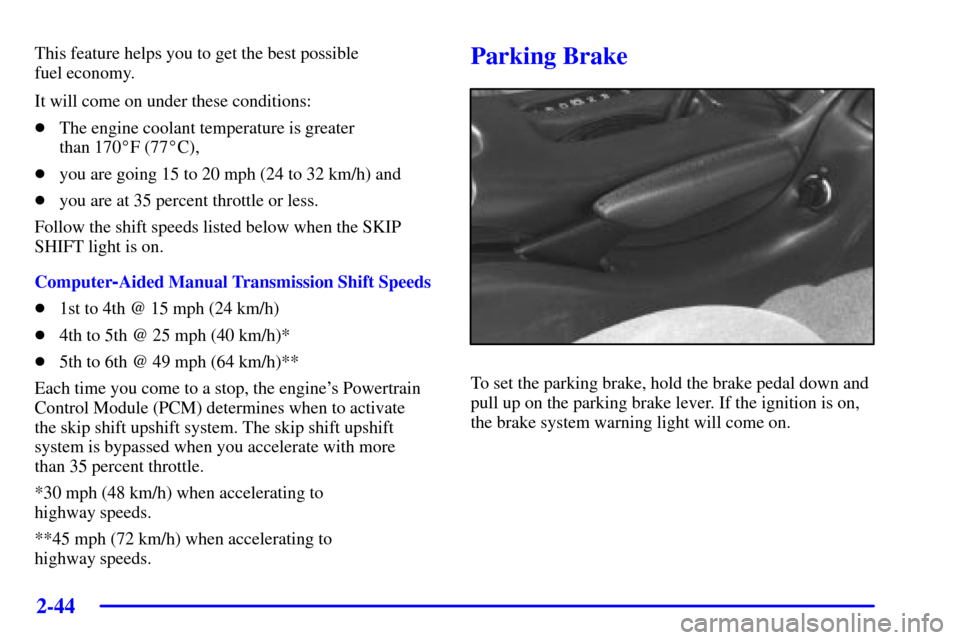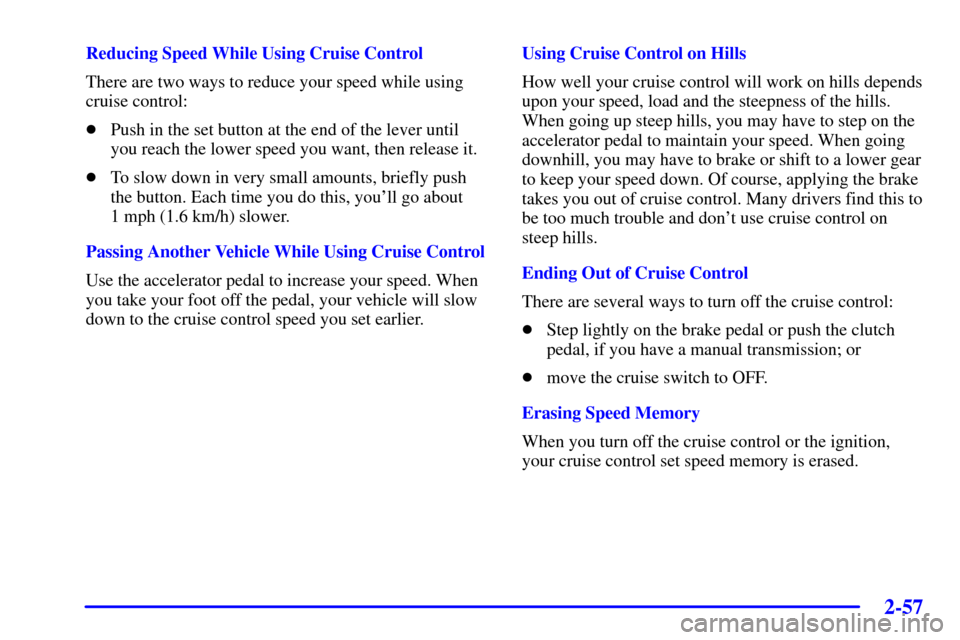Page 97 of 356

2-44
This feature helps you to get the best possible
fuel economy.
It will come on under these conditions:
�The engine coolant temperature is greater
than 170�F (77�C),
�you are going 15 to 20 mph (24 to 32 km/h) and
�you are at 35 percent throttle or less.
Follow the shift speeds listed below when the SKIP
SHIFT light is on.
Computer
-Aided Manual Transmission Shift Speeds
�1st to 4th @ 15 mph (24 km/h)
�4th to 5th @ 25 mph (40 km/h)*
�5th to 6th @ 49 mph (64 km/h)**
Each time you come to a stop, the engine's Powertrain
Control Module (PCM) determines when to activate
the skip shift upshift system. The skip shift upshift
system is bypassed when you accelerate with more
than 35 percent throttle.
*30 mph (48 km/h) when accelerating to
highway speeds.
**45 mph (72 km/h) when accelerating to
highway speeds.
Parking Brake
To set the parking brake, hold the brake pedal down and
pull up on the parking brake lever. If the ignition is on,
the brake system warning light will come on.
Page 106 of 356

2-53
Headlamp High/Low-Beam Changer
When the high beams are
on, this light located on the
instrument panel cluster
also will be on.
To change the headlamps from low beam to high or high
beam to low, pull the turn signal lever all the way
toward you. Then release it.
Windshield Wipers
You can control the windshield wipers by turning the
band with the wiper symbol on it, located on the turn
signal/multifunction lever.
For a single wiping cycle, turn the band to MIST. Hold
it there until the wipers start, then let go. The wipers will
stop after one cycle. If you want more cycles, hold the
band on MIST longer.You can set the wiper speed for a long or short delay
between wipes. This can be very useful in light rain or
snow. Turn the band to choose the delay time.
The closer to LO, the shorter the delay.
For steady wiping at low speed, turn the band away
from you to the LO position. For high
-speed wiping,
turn the band further, to HI. To stop the wipers, turn
the band to OFF.
Damaged wiper blades may prevent you from seeing
well enough to drive safely. To avoid damage, be sure to
clear ice and snow from the wiper blades before using
them. If they're frozen to the windshield, carefully
loosen or thaw them. If your blades do become
damaged, get new blades or blade inserts.
Heavy snow or ice can overload your wipers. A circuit
breaker will stop them until the motor cools. Clear away
snow or ice to prevent an overload.
Page 110 of 356

2-57
Reducing Speed While Using Cruise Control
There are two ways to reduce your speed while using
cruise control:
�Push in the set button at the end of the lever until
you reach the lower speed you want, then release it.
�To slow down in very small amounts, briefly push
the button. Each time you do this, you'll go about
1 mph (1.6 km/h) slower.
Passing Another Vehicle While Using Cruise Control
Use the accelerator pedal to increase your speed. When
you take your foot off the pedal, your vehicle will slow
down to the cruise control speed you set earlier.Using Cruise Control on Hills
How well your cruise control will work on hills depends
upon your speed, load and the steepness of the hills.
When going up steep hills, you may have to step on the
accelerator pedal to maintain your speed. When going
downhill, you may have to brake or shift to a lower gear
to keep your speed down. Of course, applying the brake
takes you out of cruise control. Many drivers find this to
be too much trouble and don't use cruise control on
steep hills.
Ending Out of Cruise Control
There are several ways to turn off the cruise control:
�Step lightly on the brake pedal or push the clutch
pedal, if you have a manual transmission; or
�move the cruise switch to OFF.
Erasing Speed Memory
When you turn off the cruise control or the ignition,
your cruise control set speed memory is erased.
Page 111 of 356
2-58
Exterior Lamps
The control located on the instrument panel to the left of
the steering column operates the exterior lamps.The exterior lamp control has three positions:
(Off): Turning the control to this position
turns off all the lamps except the Daytime
Running Lamps (DRL).
(Parking Lamps): Turning the control to
this position turns on the parking lamps, together
with the following:
�Sidemarker Lamps
�Taillamps
�License Plate Lamps
�Instrument Panel Lights
(Headlamps): Turning the control to this position
turns on your headlamps, together with the previously
listed lamps and lights.
Headlamps on Reminder
If you turn the ignition to OFF and leave the lamps on,
you will hear a chime, lasting up to five seconds. If the
lamps are still on when you open the driver's door, the
chime will sound again.
Page 112 of 356

2-59
Daytime Running Lamps / Automatic
Headlamp Control
Daytime Running Lamps (DRL) can make it easier for
others to see the front of your vehicle during the day.
DRL can be helpful in many different driving
conditions, but they can be especially helpful in the
short periods after dawn and before sunset. Fully
functional daytime running lamps are required on all
vehicles first sold in Canada.
A light sensor on top of the instrument panel
automatically turns the headlamps on, so be sure it
isn't covered.
The DRL system will not activate if the parking brake is
engaged prior to turning the ignition on.The DRL system will make your front turn signal lamps
come on when the following conditions are met:
�The ignition is on,
�the exterior lamp control is off,
�the parking brake is released, and
�it is bright enough outside.
When the DRL are on, only your front turn signal lamps
will be on. The taillamps, sidemarker and other lamps
won't be on. Your instrument panel won't be lit up
either. When you use your turn signals, the front turn
signal and the taillamp on the desired side will flash.
When it's dark enough outside, your front turn signal
lamps will go out and your headlamps will come on.
The other lamps will also come on.
When it's bright enough outside, the regular lamps will
go off, and your front turn signal lamps will come on.
As with any vehicle, you should turn on the regular
headlamp system when you need it.
Page 113 of 356
2-60 Fog Lamps (Option)
Use your fog lamps for better vision in foggy or
misty conditions.
Your fog lamp switch is
located on your console,
above the audio system.Your parking lamps must be on or your fog lamps
won't work.
To turn the fog lamps on, push the right side of the fog
lamp switch and a light on the switch will come on
indicating that the fog lamps are on. Push the left side
of the switch to turn the fog lamps off.
The fog lamps will go off whenever your high
-beam
headlamps come on. When the high
-beam headlamps
go off, the fog lamps will come on again.
If your vehicle has the content theft
-deterrent/alarm
system and your fog lamp switch is on, the fog lamps
may flash along with the parking lamps to indicate
operation of the content theft
-deterrent/alarm system.
See ªContent Theft
-Deterrent/Alarm Systemº in
the Index.
Page 114 of 356

2-61
Interior Lamps
Instrument Panel Brightness Control
This feature controls the brightness of the instrument
panel lights.
The thumbwheel for this feature is located on the
instrument panel to the left of the steering column.
Move the thumbwheel up or down to brighten or dim
the lights. If you move the thumbwheel all the way up,
your courtesy lamps will come on.
Courtesy Lamps
When either door is opened, several interior lamps go
on. These lamps are courtesy lamps. They make it easier
for you to enter and leave your vehicle.
Courtesy lamps include two map lamps on the inside
rearview mirror and other lamps throughout the interior
of your vehicle.
To prevent battery rundown, your interior lamps will be
disabled about 10 minutes after the ignition is turned to
OFF. The 10
-minute timer will be restarted if you do
any of the following:
�Turn the ignition on.
�Open either door.
�Press any button on your remote keyless entry
transmitter (option).
�Turn the interior lamps from off to on.
�Open the hatch.
Page 115 of 356

2-62 Delayed Illumination
With delayed illumination, the courtesy lamps will come
on and stay on for 25 seconds after you enter the vehicle
and close the door. They will also stay on for five
seconds after you exit the vehicle and close the doors.
Delayed illumination will be shortened if the ignition is
turned to RUN or if the power locks are activated. To
turn this feature on or off, see ªFeature Customizationº
in the Index.
Exit Lighting
With exit lighting, the interior lamps will come on when
you remove the key from the ignition to help you see
while exiting the vehicle. To turn this feature on or off,
see ªFeature Customizationº in the Index.
Front Map Lamps
Your inside rearview mirror includes two map lamps.
Each lamp has its own switch. Use the switch closest to
the lamp to turn it on. The lamps will also come on
when a door is opened.
Mirrors
Inside Day/Night Rearview Mirror
An inside rearview mirror is attached to your
windshield. The mirror pivots so that you can adjust it.
You can adjust the mirror for day or night driving. Pull
the tab for night driving to reduce glare. Push the tab for
daytime driving.